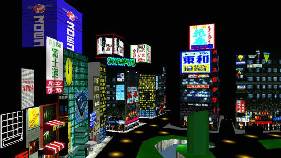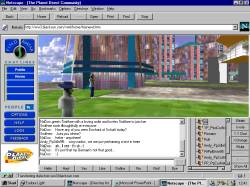|

VRML (Modelling Virtual Reality Modelling Language) provides a flexible, multi-platform environment to model urban form and move towards the construction of virtual cities. VRML files are specifically designed for distribution on the WWW, allowing a block model of a large urban environment to occupy less than 100K. However, to achieve realism in the construction of virtual urban form, VRML is highly texture dependent. The higher the number of textures used within the VRML model, the higher the degree of realism and therefore the overall impression gained by the avizen. However, due to current bandwidth constraints is it not practicable to constuct heavily texture dependent models. At present VRML 2.0 is replacing VRML 1.0
as the standard for 3D Modelling of the built
environment. VRML 2.0 allows the developer to increase
the level of achievable realism by allowing behaviors to
be assigned to objects. Behaviors allow a scene to
include features such as movement and directional sound,
significantly increasing the level of realism. However,
as with VRML 1.0, VRML 2.0 is texture dependent and
features such as directional sound and movement increase
the overall file size and therefore download time. An example of a 'typical' virtual city on the web is pictured right, Virtual Tokyo by Plannet 9 Studios. The use of textures is extensive to enable a medium level of realism. While this presents an actuate representation of Tokyo, it does not represent a Virtual City. Virtual Tokyo is characterrstic of many Virtual cities on the web in that is is merely a three dimensional representation of urban form, it does not have any social or interactive elements.
|


 Social
and basic levels of user interaction have been built into
the next level of VRML browser by
Social
and basic levels of user interaction have been built into
the next level of VRML browser by